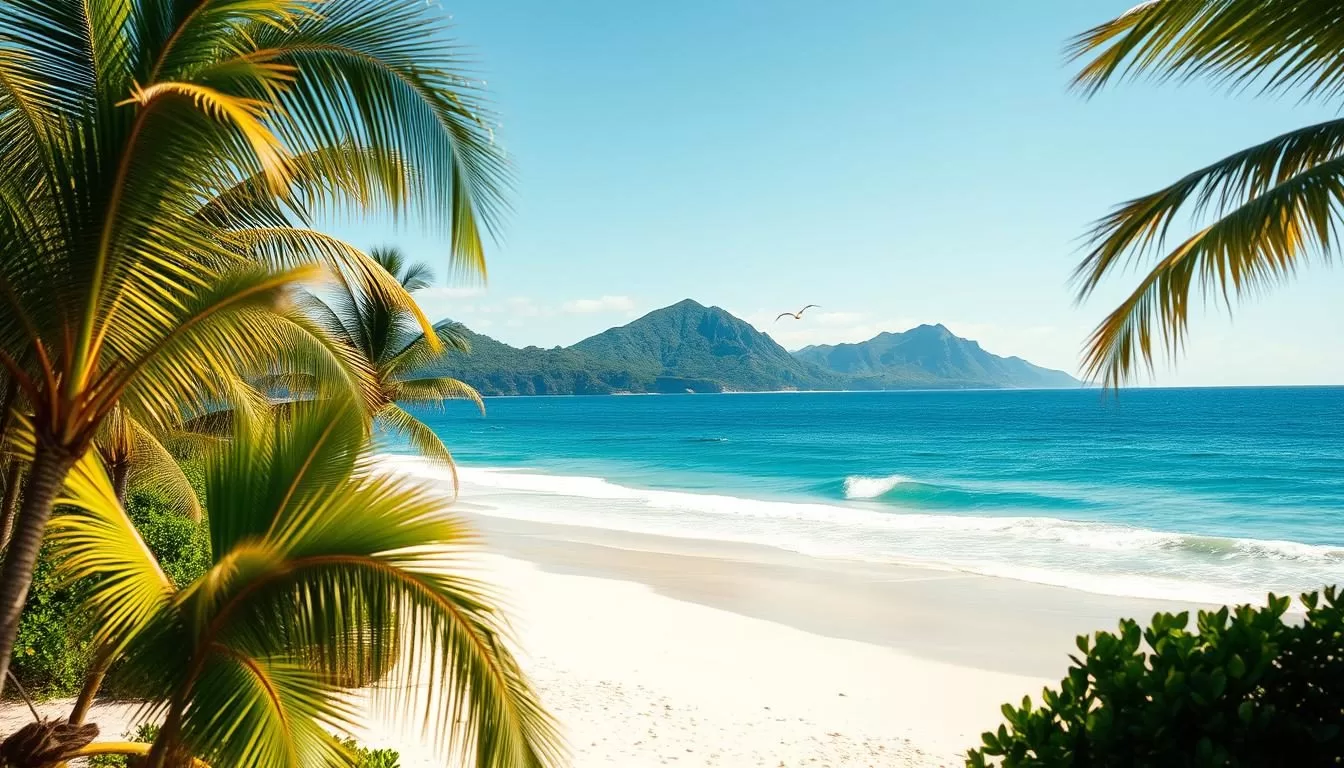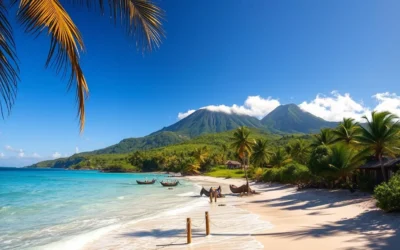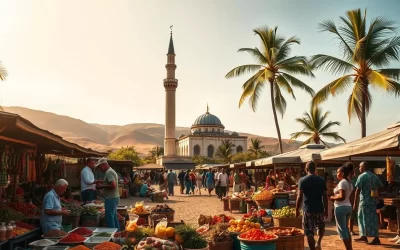Located between Madagascar and Mozambique, the Comoros Islands offer a tropical paradise with distinct seasonal variations that can significantly impact your visit.
The islands’ location in the Indian Ocean influences their climate, creating a destination with year-round warm temperatures but varying rainfall patterns. Understanding these patterns is crucial to tailor your trip accordingly.
Whether you’re interested in hiking volcanic landscapes, exploring marine parks, or simply relaxing on pristine beaches, timing your trip to align with your preferred activities is essential. By doing so, you’ll be able to pack appropriately and set realistic expectations for your journey.
Let’s explore the ideal months to visit Comoros based on your travel preferences and weather tolerance.
Understanding Comoros’ Tropical Climate
Comoros, an archipelago off the coast of East Africa, boasts a tropical climate that is characterized by two distinct seasons. This climate is influenced by its geographical location and results in warm conditions throughout the year.
The Two Main Seasons of Comoros
The Comoros archipelago experiences a tropical climate with two main seasons: the dry and cool season from May to October, and the hot and humid season from November to April. Temperatures remain relatively stable, typically ranging from 24°C to 29°C throughout the year. The dry season is ideal for outdoor activities due to cooler temperatures and less rainfall, while the wet season brings higher humidity and more frequent rainfall, but also lush landscapes and fewer tourists.
| Season | Months | Characteristics |
|---|---|---|
| Dry and Cool | May to October | Cooler temperatures, less rainfall |
| Hot and Humid | November to April | Higher humidity, more rainfall |
How Geography Affects Weather Across the Islands
The geography of Comoros significantly influences its climate. The islands’ volcanic origins and mountainous terrain create microclimates across different regions. For instance, Mount Karthala on Grande Comore affects local weather patterns, creating varying conditions even within the same island. Additionally, ocean currents and trade winds contribute to predictable weather patterns, helping you plan your visit. Elevation differences between coastal areas and inland regions also impact daily temperatures and rainfall patterns.
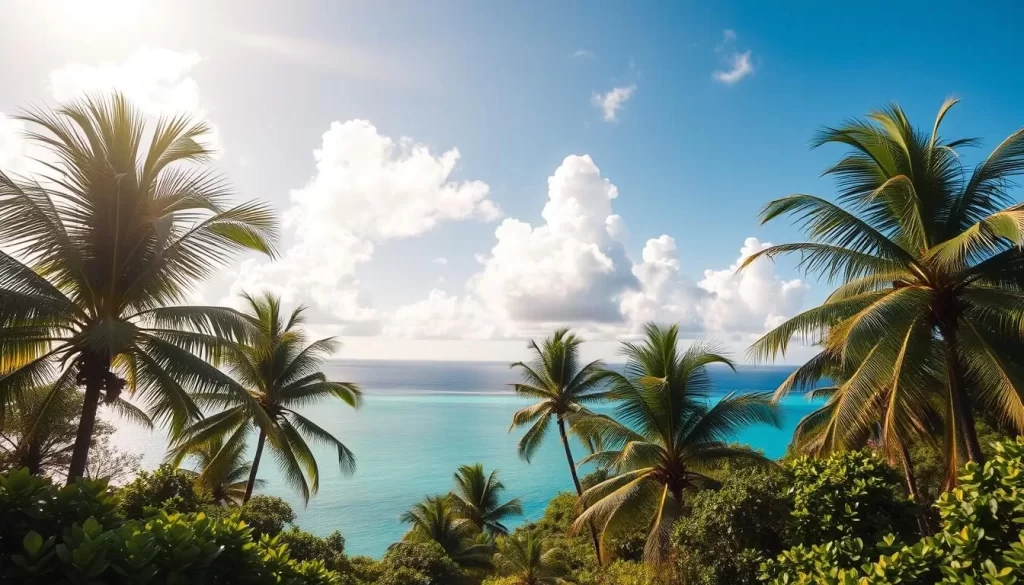
Comoros: Best Months for a Weather-Savvy Trip
When planning your trip to Comoros, understanding the best months to visit can significantly enhance your travel experience. The archipelago’s tropical climate means that the weather varies significantly throughout the year, impacting the suitability of different activities and travel plans.
April to November: The Ideal Dry Season
The dry season, spanning from April to November, is considered the best time to visit Comoros. During this period, the weather is characterized by mild temperatures and low humidity, making it ideal for outdoor activities such as hiking, wildlife viewing, and exploring the national parks. The months of June to September are particularly favorable, offering the most agreeable weather conditions for tourists. As the dry season progresses, the humidity continues to decrease, and rainfall becomes less frequent, creating optimal conditions for enjoying the islands’ natural beauty.
You can expect a gradual transition from the wet to dry seasons in April, with a noticeable decrease in humidity and rainfall. This transition makes April an attractive time to visit, as the weather begins to stabilize, offering a comfortable environment for various activities.
Weather Patterns Month by Month
A closer look at the weather patterns month by month can help you pinpoint the exact time that aligns with your travel preferences. Here’s a breakdown:
| Month | Weather Conditions | Humidity Level | Recommended Activities |
|---|---|---|---|
| April | Mild, transitioning to dry | Moderate | Hiking, cultural experiences |
| June | Dry, sunny | Low | Beach relaxation, wildlife viewing |
| September | Dry, pleasant | Low | Outdoor activities, national parks |
| November | Transitioning to wet | Increasing | Cultural experiences, last chance for dry activities |
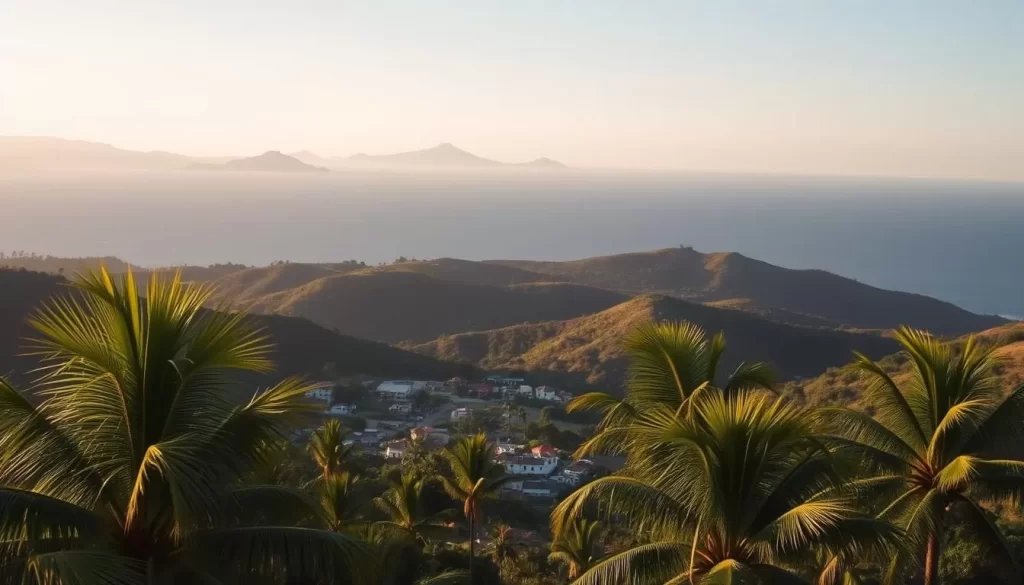
Understanding these monthly variations allows you to plan your trip according to your preferences and the activities you have planned. Whether you’re looking for the peak dry season or the shoulder months, Comoros offers a range of experiences tailored to different traveler needs.
Exploring Grande Comore: Seasonal Considerations

To make the most of your visit to Grande Comore, it’s essential to consider the seasonal weather patterns that impact the island’s various attractions. The island offers a range of destinations and activities that are best experienced during specific weather conditions.
Mount Karthala Hiking: When to Attempt the Climb
The most renowned trail on Grande Comore is Mount Karthala, an active volcano and the highest peak in the Comoros. The optimal time to visit for hiking is during the dry season, from May to November, when the weather is more favorable, with less rainfall and milder temperatures. This period enhances the overall experience and safety of the hike.
Moroni and Coastal Activities: Optimal Timing
For those interested in exploring Moroni, the capital city, or enjoying coastal activities such as swimming, snorkeling, or simply relaxing on the beach, the time of year significantly affects the conditions. The dry season, from May to November, is generally considered the best period for these activities due to clearer seas and more pleasant travel conditions.
Understanding these seasonal variations will help you plan your travel itinerary to Grande Comore effectively, ensuring that you make the most of your experience on the island, regardless of when you choose to visit.
Mohéli and Anjouan Islands: Weather-Based Travel Guide
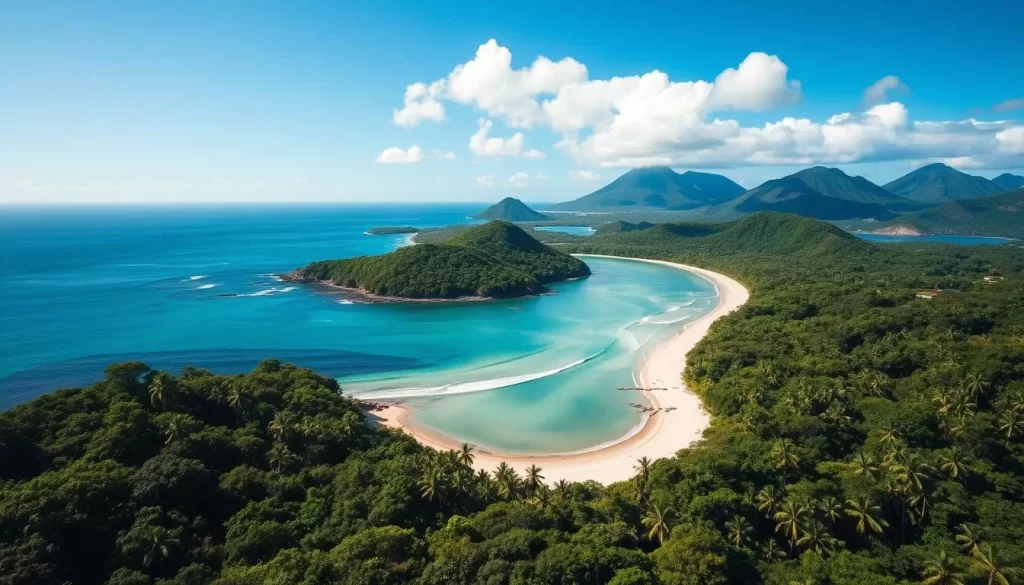
The islands of Mohéli and Anjouan, part of the Comoros archipelago, offer unique travel experiences shaped by their regional weather conditions. While both islands share some similarities with Grande Comore, their distinct geography and microclimates create different travel opportunities.
Mohéli Marine Park: Best Months for Wildlife Viewing
Mohéli Marine Park is renowned for its rich marine biodiversity. The best time to visit for wildlife viewing is during the dry season, from April to November, when the waters are clearest and marine species are most active. This period is ideal for snorkeling and diving, with comfortable humidity levels enhancing your overall experience.
The dry season also coincides with the nesting season of sea turtles, making it an excellent time for turtle watching. Additionally, the clear waters offer excellent visibility for spotting dolphins and whales, providing an unforgettable experience.
Anjouan’s Microclimate: When to Experience Its Unique Beauty
Anjouan’s unique microclimate, characterized by lush vegetation and slightly different weather patterns than the other islands, makes it a fascinating destination. The island’s varied elevations and exposure to prevailing winds create comfortable conditions for exploring its natural beauty, including waterfalls and hiking trails, during the dry season.
Visiting Anjouan during the dry months (April to November) allows you to enjoy its spice plantations, such as vanilla and ylang-ylang, under optimal weather conditions. The relatively lower humidity during these months enhances the comfort of exploring the island’s historic capital, Mutsamudu, and its surrounding landscapes.
Navigating the Rainy Season in Comoros
Comoros’ rainy season, spanning from November to April, presents both challenges and opportunities for travelers. Understanding what to expect during these months is crucial for planning a successful trip.
November to April: What to Expect
During the rainy season, Comoros experiences high temperatures, high humidity, and frequent rainfall. These weather conditions can make outdoor activities challenging and, at times, some roads may become impassable due to flooding. The period from January to May is also a time when Comoros can be affected by tropical cyclones, making it essential to monitor weather forecasts closely if you’re planning to travel during these months.
| Month | Average Rainfall | Average Temperature |
|---|---|---|
| November | 100 mm | 28°C |
| December | 150 mm | 29°C |
| January | 180 mm | 30°C |
| February | 200 mm | 30°C |
| March | 220 mm | 31°C |
| April | 150 mm | 30°C |
Tips for Traveling During Wetter Months
Despite the challenges, traveling to Comoros during the rainy season has its advantages, including lush landscapes, fewer tourists, and lower prices at many accommodations. To make the most of your trip, it’s essential to be prepared for the conditions. Packing light, breathable clothing and waterproof gear can make a significant difference. Additionally, focusing on indoor activities or outdoor experiences that are less affected by rain can help you navigate the times when outdoor activities are limited.
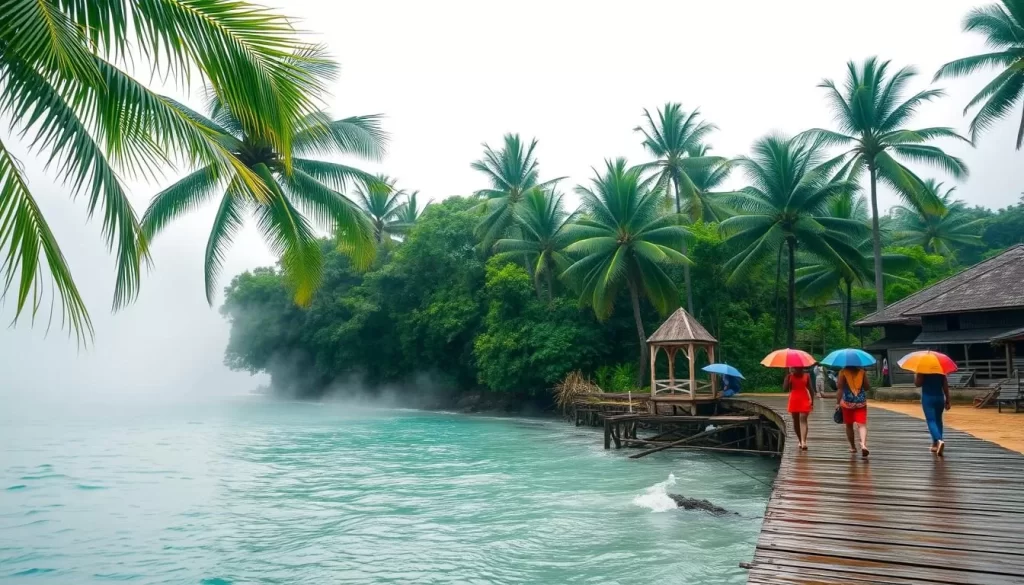
When planning your Comoros travel, consider the potential for transportation delays or route changes due to weather. Staying informed about local weather forecasts and being flexible with your itinerary can help mitigate these challenges. By understanding and adapting to the rainy months and associated humidity, you can have a rewarding experience in Comoros.
Planning Your Trip: Practical Weather Considerations
Effective trip planning to Comoros requires a deep understanding of how the weather affects various aspects of your journey. To ensure a smooth and enjoyable experience, it’s crucial to consider the practical implications of the weather on your travel plans.
Packing Essentials for Different Seasons
When traveling to Comoros, packing the right clothing is essential. During the dry season, from April to November, lightweight and breathable clothing is recommended. In contrast, the rainy season, from November to April, requires waterproof gear and quick-drying clothes. You should also consider the humidity levels and pack accordingly to stay comfortable throughout your trip.
Transportation Between Islands: Weather Impacts
Traveling between the islands of Comoros can be an adventure. The primary mode of transportation is by boat, and it’s essential to be flexible as services may not always run on schedule. Weather conditions significantly impact ferry services, with the dry season offering more reliable transportation. If you’re traveling during the rainy season, consider flights as an alternative, despite the higher prices.
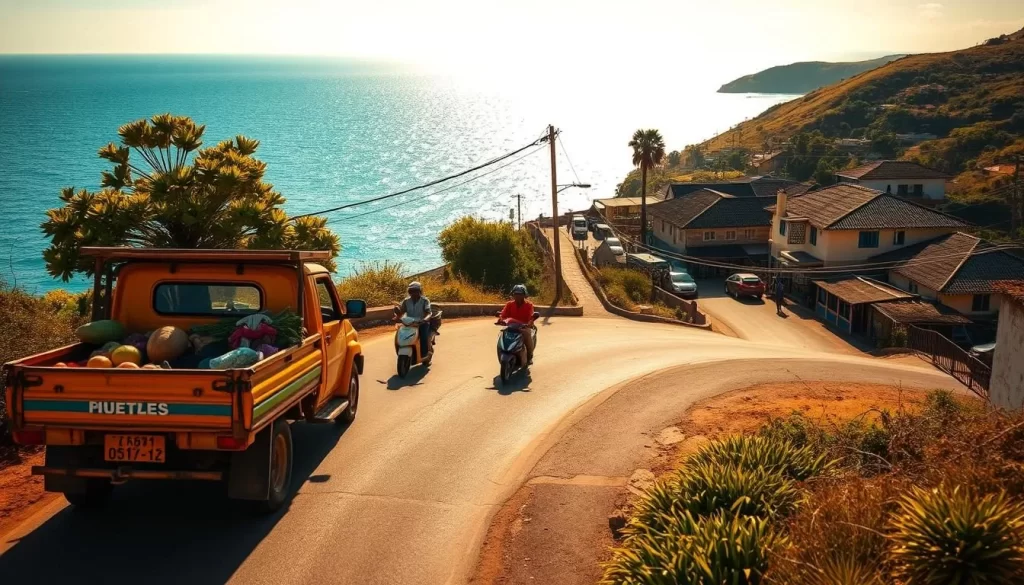
Accommodation Options Throughout the Year
Comoros offers a range of accommodations to suit different budgets, from budget-friendly guesthouses at around $20 per night to luxury resorts at $100 or more per night. The availability and prices of these accommodations vary with the seasons. During the dry season, you can expect higher demand and potentially higher prices. However, during the shoulder season, you may find better deals. It’s advisable to book in advance to secure the best options at reasonable prices.
By understanding how the weather affects packing, transportation, and accommodation, you can plan a more successful and enjoyable trip to Comoros. Whether you’re looking for a budget-friendly option or a luxury experience, being prepared for the weather conditions will help you make the most of your trip.
Conclusion: Making the Most of Comoros’ Climate
Embracing the tropical climate of Comoros is key to enjoying your trip to this less-visited archipelago. As you’ve learned, the weather varies significantly across the year, influencing the type of experiences you can have on the islands.
The dry season, from April to November, is ideal for most travelers, offering pleasant temperatures and lower humidity. However, considering the shoulder seasons can also be rewarding, with fewer tourists and unique opportunities to engage with the local environment and culture.
When planning your trip to Comoros, remember that the weather impacts not just your outdoor activities but also your overall travel experience. Understanding the patterns of temperature, humidity, and rainfall will help you make the most of your time on the islands.
- Pack accordingly for the season you plan to visit.
- Adjust your daily schedule to work with the weather, not against it.
- Consider visiting during the shoulder season for a more serene experience.
By being mindful of the weather and its implications, you can have a more rewarding and enjoyable experience in Comoros. Whether you’re looking for a relaxing beach holiday or an immersive cultural experience, timing your visit right is crucial.
In conclusion, Comoros offers a unique travel experience that is deeply influenced by its climate. By understanding and embracing this, you can make the most of your visit to Comoros and enjoy all that the islands have to offer.
The above is subject to change.
Check back often to TRAVEL.COM for the latest travel tips and deals.
